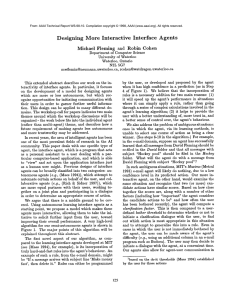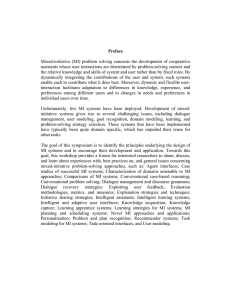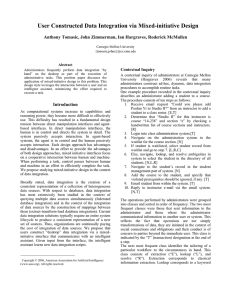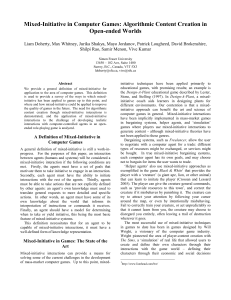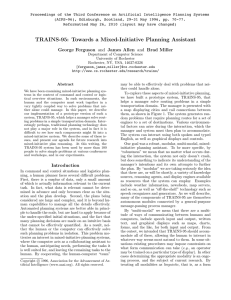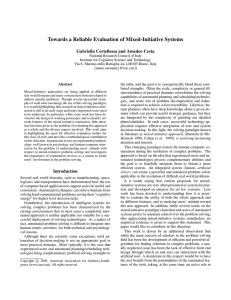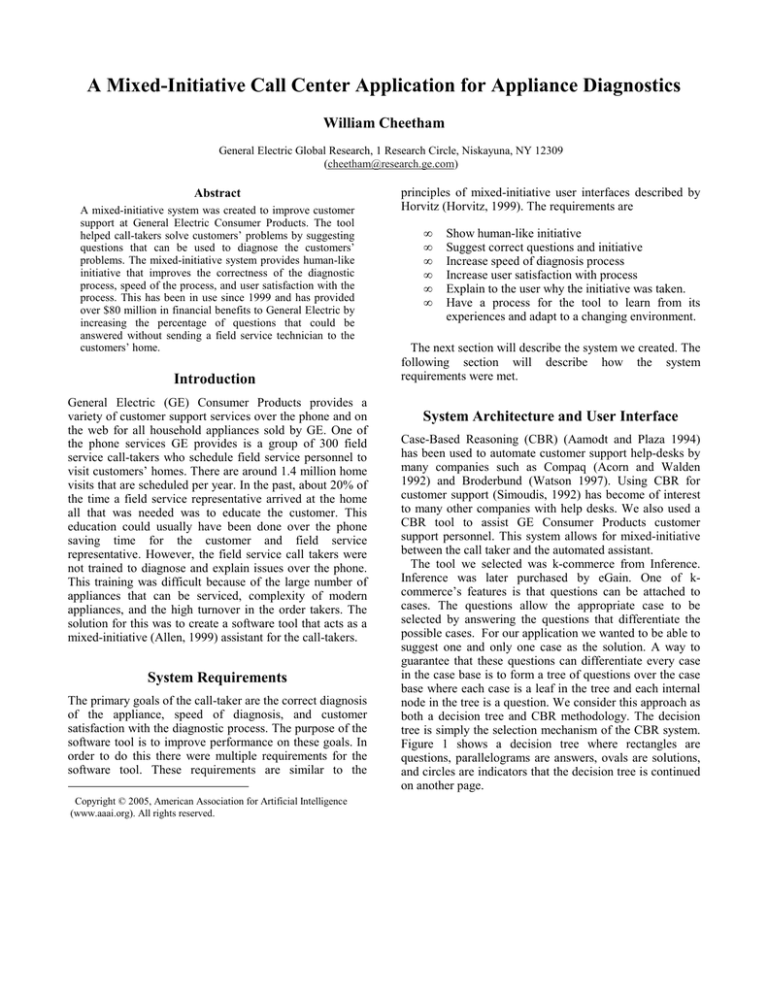
A Mixed-Initiative Call Center Application for Appliance Diagnostics
William Cheetham
General Electric Global Research, 1 Research Circle, Niskayuna, NY 12309
(cheetham@research.ge.com)
Abstract
A mixed-initiative system was created to improve customer
support at General Electric Consumer Products. The tool
helped call-takers solve customers’ problems by suggesting
questions that can be used to diagnose the customers’
problems. The mixed-initiative system provides human-like
initiative that improves the correctness of the diagnostic
process, speed of the process, and user satisfaction with the
process. This has been in use since 1999 and has provided
over $80 million in financial benefits to General Electric by
increasing the percentage of questions that could be
answered without sending a field service technician to the
customers’ home.
Introduction1
General Electric (GE) Consumer Products provides a
variety of customer support services over the phone and on
the web for all household appliances sold by GE. One of
the phone services GE provides is a group of 300 field
service call-takers who schedule field service personnel to
visit customers’ homes. There are around 1.4 million home
visits that are scheduled per year. In the past, about 20% of
the time a field service representative arrived at the home
all that was needed was to educate the customer. This
education could usually have been done over the phone
saving time for the customer and field service
representative. However, the field service call takers were
not trained to diagnose and explain issues over the phone.
This training was difficult because of the large number of
appliances that can be serviced, complexity of modern
appliances, and the high turnover in the order takers. The
solution for this was to create a software tool that acts as a
mixed-initiative (Allen, 1999) assistant for the call-takers.
System Requirements
The primary goals of the call-taker are the correct diagnosis
of the appliance, speed of diagnosis, and customer
satisfaction with the diagnostic process. The purpose of the
software tool is to improve performance on these goals. In
order to do this there were multiple requirements for the
software tool. These requirements are similar to the
1
Copyright © 2005, American Association for Artificial Intelligence
(www.aaai.org). All rights reserved.
principles of mixed-initiative user interfaces described by
Horvitz (Horvitz, 1999). The requirements are
•
•
•
•
•
•
Show human-like initiative
Suggest correct questions and initiative
Increase speed of diagnosis process
Increase user satisfaction with process
Explain to the user why the initiative was taken.
Have a process for the tool to learn from its
experiences and adapt to a changing environment.
The next section will describe the system we created. The
following section will describe how the system
requirements were met.
System Architecture and User Interface
Case-Based Reasoning (CBR) (Aamodt and Plaza 1994)
has been used to automate customer support help-desks by
many companies such as Compaq (Acorn and Walden
1992) and Broderbund (Watson 1997). Using CBR for
customer support (Simoudis, 1992) has become of interest
to many other companies with help desks. We also used a
CBR tool to assist GE Consumer Products customer
support personnel. This system allows for mixed-initiative
between the call taker and the automated assistant.
The tool we selected was k-commerce from Inference.
Inference was later purchased by eGain. One of kcommerce’s features is that questions can be attached to
cases. The questions allow the appropriate case to be
selected by answering the questions that differentiate the
possible cases. For our application we wanted to be able to
suggest one and only one case as the solution. A way to
guarantee that these questions can differentiate every case
in the case base is to form a tree of questions over the case
base where each case is a leaf in the tree and each internal
node in the tree is a question. We consider this approach as
both a decision tree and CBR methodology. The decision
tree is simply the selection mechanism of the CBR system.
Figure 1 shows a decision tree where rectangles are
questions, parallelograms are answers, ovals are solutions,
and circles are indicators that the decision tree is continued
on another page.
Which refrigerator
compartment is too cold?
A, B, 1, 2, or 3
More than 3 or C
Fresh
Food
Mixed-Initiative Requirements
On what setting is the
freezer compartment
temperature?
Freezer
Schedule
service
Lower freezer compartment temperature setting;
Wait 24 hours to see if problem solved
Human-like Initiative
What type of refrigerator do you
have? Is the freezer on the top,
bottom, or side?
Continued
Side by
Side
Side
Continued
Bottom
Mount
Bottom
Top
The system described was designed to meet the
requirements for a mixed-initiative system.
Is there one door on
the outside or two?
Continued
Cycle
Defrost /
Manual
One
Two
Do you defrost the
freezer yourself?
No
Yes
Continue
TMNF
Continued
Cycle Defrost
/ Manual
Figure 1: Decision Tree
User Interface
The user interface of the system is shown in Figure 2. The
questions that the assistant suggests are listed at the top of
the screen. There is a pull down list with the set of possible
answers to each question. The call taker can answer any of
the questions in any order. The bottom half of the screen
lists the previously answered questions, which can be
changed at any time. When a question from the top half is
answered it moves to the bottom and the top is repopulated
with new questions.
Figure 2: Internal Pilot User Interface
Humans often show initiative. However, they need to be
careful to take initiative when it will be useful and not
perform the initiative if it will not be useful. One way
humans use to determine if initiative is warranted and then
take the initiative is the following.
1. Have understanding of goals and priorities
2. Have understanding of current situation
3. Identify a task from current situation that can help
goals
4. Identify potential benefits and problems from
doing task
5. Determine confidence that task should be
performed
a. high – do task
b. low – don’t do task
c. medium – ask if task should be done
6. Have ability to perform task
7. Inform others task has been done
Items one, two, and three are needed to correctly identify
opportunities for taking initiative. Item four gathers
information about the advantages and disadvantages of
tacking the initiative. Care must be taken to identify the
disadvantages. Possible disadvantages include
• Bothering the user
• Doing an unwanted task
• Doing a low priority task instead of a high priority
one
• Being destructive or wasteful
The fifth item is weighing the advantages and
disadvantages. If the advantages greatly outweigh the
disadvantages then the initiative should most likely be
taken. If the disadvantages outweigh the advantages then
the initiative should not be taken. If neither of the
advantages nor disadvantages outweighs the other then a
human can ask another person (e.g., supervisor) if the
initiative should be taken. The human needs the ability to
perform the task and should inform others effected that the
task has been completed.
Software assistants can use the same set of steps when
they attempt to show initiative. They should understand the
goals, priorities, current situation, and set of possible
initiative actions. They should be able to identify
advantages and disadvantages. Disadvantages of an
automated assistant taking imitative include
• Bothering the user
• Locking the user out (stealing cycles)
• Acting in an unknown way
• Undoing users desired actions
• Making the user undo the computers actions
• Keeping the user from doing tasks (2001’s HAL)
The system should be able to determine the confidence
that the initiative should be taken (Cheetham and Price,
2004). Then, the system needs to take the action and inform
the user of the action taken.
Correctness
We found that call-takers quickly lost trust in the system if
it gave poor suggested questions or initiative. That is why
we went though the additional effort of creating a decision
tree on top of the case base. K-commerce does not require
a decision tree; it can automatically suggest questions from
the most likely cases. However, at the start of the diagnosis
process it is often unclear which cases are most likely. We
created diagnostic trees for each possible symptom of each
type of appliance to improve the correctness of the system
and retain the users trust. Figure 1 shows the tree for a sideby-side refrigerator where a compartment is too cold.
Multiple methods can be used to reduce the cost of an
incorrect suggested question. Some of these are
• Provide multiple suggestions from which the user
can pick.
• Do not force the user to act on the suggestion.
• Unobtrusively present the suggested questions to
the call taker
Similarly, a false positive, where incorrect initiative is
taken, is usually much worse than a false negative, where
correct possible advice is not given. Because of this we
concluded that the initiative taken by the automated system
should only be given when it is highly likely to be correct.
If initiative is taken and not correct then it could distract,
slow, and/or annoy the user.
Speed
Before this system was fielded much of the information
needed to diagnose a problem was in manuals and tacit
knowledge of a few call takers. Customers would often be
placed on hold while the correct manual was found and
searched or the correct expert was available and informed
of the issue. Having a system that could sore this
information, provide it automatically, and guide the calltaker in the diagnosis removed many of these frustrating
delays.
Another way the diagnosis can be done more rapidly is to
have the system automatically answer the question that it is
confident it can answer correctly. Some of these questions
include information that can be obtained from other sources
than the user. Information about the user, such as models
owned and previous diagnostics sessions, can be stored in a
database. When questions require this information it can be
answered automatically. One future goal for high-end
appliances is to include a phone or Ethernet connection so
additional diagnostic data, such as a temperature sensor,
can be sent directly to the diagnostic tool, allowing it to
take initiative on a wider set of questions. It is important
that the user can change the answers when a question is
answered automatically.
The flow of control of the mixed-initiative system is
shown in Figure 3. When a new call is received the system,
represented by the Agent, searches for any questions that
are needed for the diagnosis, automatically answers as
many of these questions as possible, then passes initiative
back to the user. The user can now take action to answer as
many questions as needed. After each question is answered
the agent can update the list of questions, automatically
answer new questions, or do nothing. The call-taker is not
forced to answer any questions and can jump to a competed
diagnosis at any time during the question answer process.
We try and have the agent do as much of the work as
possible, so the process is as quick as possible.
Figure 3: Mixed-Initiative Flow
Finally, the action suggested after diagnosis is completed
can be automated. The call-taker could step the user
through a pre-created repair process, or email / fax the
process to the user. If parts are required, one click off the
solution can place an order for the parts to be sent to the
address of the customer. If a service technician is required,
the time for that visit can be scheduled and description of
the problem automatically sent to the technician for their
review.
User Satisfaction
The customers’ satisfaction is primarily based on the
correctness, speed, and professionalism of the help
provided by the call-taker. We have already described how
the system helps the correctness and speed of the process.
The system also helps the professionalism of the call-taker
by providing the exact wording that should be used to ask a
question to the customer. Each call taker is given two
weeks of training before they are able to take calls from a
customer. This training used to involve education about the
appliances and how to professionally interact with a
customer. Now, it is only on professionalism and the
system acts as “on the job” training about the appliances.
satisfaction also showed the customer preferred having
their issues solved without the need for a house visit.
Conclusion
Explanations
Call-takers and customers often wonder why the system is
suggesting a specific question. The user trust is enhanced if
there is a clear explanation for why the system is taking
some action. When the questions are created we often also
create an explanation for why the question should be asked.
This explanation can be displayed for the call-taker by
clicking on the question in the user interface.
Maintenance
Every time the case base was used to answer a call a
description of the call was written to a reporting database.
The description included start time, end time, caller phone
number, call taker ID, type of appliance, short text
description of issue, all questions asked by the system, all
answer given to these questions, final diagnosis suggested,
and if this answer was accepted by the caller. Each week a
case author would analyze this information in the reporting
database for every call that was taken for the week. The
author was looking for any trends and especially any times
a caller would not be satisfied by a suggestion. Any trends
or outstanding items would be discussed in a weekly
feedback meeting with the call-takers. The result of the
feedback meetings would be a few changes in the case
base. These changes would be made immediately and
reviewed in the next weeks meeting. The call takers were a
valuable part of the development team and felt ownership
in the case base when the pilot test was finished.
Results
Before the system was implemented the call takers were
only using their personal experience and paper documents
to determine when a field service representative was or was
not needed. Even though feedback from service technicians
indicated that 20% of the calls could be answered on the
phone, they were only successful on 3.9% of the calls. A
cost benefit analysis of this problem showed that creating a
mixed-initiative system would cost one million dollars for
software, development time, domain expert time, and
ongoing maintenance costs for the first five years, but the
benefit from answering just 8% of calls was over two
million per year.
The system was deployed to the 300 order takers in June
of 1999. The percentage of calls that could be correctly
answered over the phone, without sending a field service
representative, increased from 3.9% to 12.3%. The
average call times decreased slightly, from 256 seconds to
232 seconds. Since each service call that is handled over
the phone saves over $50 the system has resulted in a
savings of over $80 million from 1999 to 2005. The cost of
development, including time of developers and purchased
software, was $1.2 million. Surveys of customer
GE Consumer Products has been successful using this
mixed-initiative system to provide customer support. The
system contains exhaustive knowledge about appliance
problems and the questions needed to diagnose them. The
human call-taker provides some knowledge about
appliances and professional interface between our
customers and the diagnostic knowledge stored in the tool.
The team of computer system and human call-taker
performs better than the call-takers had before the system
was created.
References
Aamodt, A., Plaza, E., 1994. Case-Based Reasoning:
Foundational Issues, Methodological Variations, and System
Approaches, AICOM, Vol. 7, No. 1.
Acorn, T., Walden, S., 1992. SMART: Support Management
Cultivated Reasoning Technology for Compaq Customer Service,
In IAAI 4, Cambridge, MA. AAAI Press / MIT Press.
Allen, J. (1999). Mixed-initiative interaction. IEEE Intelligent
Systems, 6, 14-16.
Cheetham, W., Price, J., (2004). Measures of Solution Accuracy
in Case-Based Reasoning Systems, Seventh European Conference
on Case-Based Reasoning, Madrid, August 30 - September 2.
Horvitz, E. (1999). Principles of mixed-initiative user interfaces.
Proceedings of the Conference on Human Factors in Computing
Systems (pp. 159-166).
Thomas, H., Foil, R., Dacus, J., 1997. New Technology Bliss and
Pain in a Large Customer Service Center. Lecture Notes in
Computer Science, Vol. 1266. Springer-Verlag, Berlin
Heidelberg New York. pp. 166-177.
Simoudis, E., 1992. Using Case-Based Reasoning for Customer
Technical Support. IEEE Expert 7(5), pp. 7-13.
Watson, I., 1997. Applying Case-Based Reasoning: Techniques
for Enterprise Systems. San Francisco, Cal. Morgan Kaufmann.

